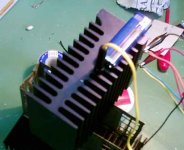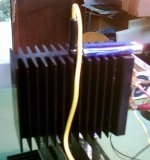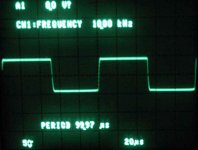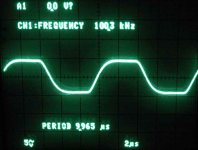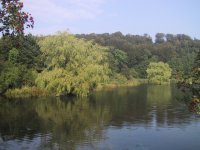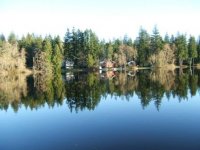As long as my heatsinks are hot I am happy. I seen my amp in much worse shape not working.
😀
there are few pictures from today's passive burning test of my zillionth version of heatsinks for Babelfish......I didn't even gave final version of sketch for box to my friend carpenter (even if he already made some work),just because little bulb in my head didn't lighted yet,regarding nicest and most effective physical layout......
anyway-interesting things one can made with variac (not destroyer 😉 few burnie burnie dale golden resistors , adequate donut and temp meter.
so-I burned exactly 100 Watts of dissipation on back of this nice 1,8 kg heatsink ;after enough time,temp settled on 70*C ;
after that I put 120mm/12Vdc Papst vent,connected on 7V5 on one side of heatsink,approximately 15 mm away of it.
temperature decreased at 55*C...........more than enough for my purpose-one heatsink per 100W/channel Babelfish furnace.same papst will be mutual for both heatsinks,probably breezing at just one side of each heatsink....ya know-cosmetical reasons will not allow me to make sort of standard tunnel.
hehe-almost forget-room temperature was healthy 29*C
not bad at all,takin' in account that Papst was barely heared on this voltage,even in front of my nose/ears/spectacles.......
seems that sketch flowwwwwwws slowly from back of my head......... 😉
Attachments
Temp
Thats funny. That is what my temp is outside. Inside it is warmer with the sun shinning on the home.
It has been about 34 Celsius this week and will be getting up to 37 by mid summer here. I am not looking forward to that warm, because I would have to stop listening to my Aleph with my room souring at least as warm or warmer in my upper listening room.
choky said:hehe-almost forget-room temperature was healthy 29*C
Thats funny. That is what my temp is outside. Inside it is warmer with the sun shinning on the home.
It has been about 34 Celsius this week and will be getting up to 37 by mid summer here. I am not looking forward to that warm, because I would have to stop listening to my Aleph with my room souring at least as warm or warmer in my upper listening room.

Re: square wave photos
I think that the edge rounding off is due to the internal capacitors forming integrators with the internal resistances. Even if I see the edge rounding off somewhat at 100KHz, I would not worry about it because the rise time (slew rate?) is still short enough to cover frequencies higher than the 100KHz.
Anyhow, I would like to have a look at your square waves. 😎
Regards
JH
BillWW said:
The 1 pF was placed over the 220K feedback resister to reduce a slight sharp peak or ringing on the square wave. I noticed it rounded the edge of the square wave more though, so I hope to get rid of this peak on the square wave and less rounding of the square wave.
I think that the edge rounding off is due to the internal capacitors forming integrators with the internal resistances. Even if I see the edge rounding off somewhat at 100KHz, I would not worry about it because the rise time (slew rate?) is still short enough to cover frequencies higher than the 100KHz.
Anyhow, I would like to have a look at your square waves. 😎
Regards
JH
choky said:is it better now?

Hi Choky,
a pretty similar circuit:
http://www.diyaudio.com/forums/showthread.php?postid=619863#post619863
The cascode incerase dramatic the performance and is very low noise.
😎 Adam
acaudio said:
Hi Choky,
a pretty similar circuit:
http://www.diyaudio.com/forums/showthread.php?postid=619863#post619863
The cascode incerase dramatic the performance and is very low noise.
😎 Adam
I knew that it can work as preamp ,too;
tnx for tip ; just another proof that I always chase for something already "invented" .......... 😉
I searched board for UGS before,but from other reasons ,so I just didn't connected it (in my head) with cut'n'paste jobie with Oly's mini amp......
O tempora,O mores!
😉
Re: Re: square wave photos
Well, I settled with 680 pF on the collector and base of the mpsa18 fet. I found this gave a slightly better square wave compared to the .001 uF at lower impedance loads such as 4 or 2 ohms.
I further ended up with 2 pF over the 220k feedback resister. I found if I was going to use an 8 ohm speaker, I could have added 3 pF for a more flat response at 1Khz.
Here are the three photos with 680 pF across the base, collector of the mpsa18 and the 2 pF across the 220k ohm feedback resister.
The .001 uF and 680 pF were the most stable with the base and collector in this jfet front end. Nothing was as nice as that, so if others build this amp place the 680 pF or .001 uF across the base and collector of the mpsa18 as in other aleph schematics.
If you will run lower than 8 ohms, I would now recommend 2 pF or if 8 ohms or higher 3 pF or perhaps more if you run 16 ohms. I did not meter for 16 ohms though.
jh6you said:
I think that the edge rounding off is due to the internal capacitors forming integrators with the internal resistances. Even if I see the edge rounding off somewhat at 100KHz, I would not worry about it because the rise time (slew rate?) is still short enough to cover frequencies higher than the 100KHz.
Anyhow, I would like to have a look at your square waves. 😎
Regards
JH
Well, I settled with 680 pF on the collector and base of the mpsa18 fet. I found this gave a slightly better square wave compared to the .001 uF at lower impedance loads such as 4 or 2 ohms.
I further ended up with 2 pF over the 220k feedback resister. I found if I was going to use an 8 ohm speaker, I could have added 3 pF for a more flat response at 1Khz.
Here are the three photos with 680 pF across the base, collector of the mpsa18 and the 2 pF across the 220k ohm feedback resister.
The .001 uF and 680 pF were the most stable with the base and collector in this jfet front end. Nothing was as nice as that, so if others build this amp place the 680 pF or .001 uF across the base and collector of the mpsa18 as in other aleph schematics.
If you will run lower than 8 ohms, I would now recommend 2 pF or if 8 ohms or higher 3 pF or perhaps more if you run 16 ohms. I did not meter for 16 ohms though.
100Khz square wave
Here is the 100Khz square wave with 680 pF and 2 pF compensation caps.
I think the above values were good for my application, because at 4 or 2 ohms the leading edge will round more than the above 8 ohm load resister did.
So, comments. How do my square waves look on my Aleph 3 using 2 output mosfets per channel btw Choky. Except for my j176 jfet input LTP.
Also, I went back to 390 ohms for the current resister to the LTP.
Regards, Bill
I think this project looks done now. Unless others think it needs additional work. 😀
Here is the 100Khz square wave with 680 pF and 2 pF compensation caps.
I think the above values were good for my application, because at 4 or 2 ohms the leading edge will round more than the above 8 ohm load resister did.
So, comments. How do my square waves look on my Aleph 3 using 2 output mosfets per channel btw Choky. Except for my j176 jfet input LTP.
Also, I went back to 390 ohms for the current resister to the LTP.
Regards, Bill
I think this project looks done now. Unless others think it needs additional work. 😀
Attachments
Re: 100Khz square wave
for me-that looks good enough 😉
sound?
is all that work with conversion to jfets worthwhile to you ?
anyway-lot's of work,and obviously, you also learned more than few things-and that is most important : fun and learning 😉
BillWW said:Here is the 100Khz square wave with 680 pF and 2 pF compensation caps.
I think the above values were good for my application, because at 4 or 2 ohms the leading edge will round more than the above 8 ohm load resister did.
So, comments. How do my square waves look on my Aleph 3 using 2 output mosfets per channel btw Choky. Except for my j176 jfet input LTP.
Also, I went back to 390 ohms for the current resister to the LTP.
Regards, Bill
I think this project looks done now. Unless others think it needs additional work. 😀
for me-that looks good enough 😉
sound?
is all that work with conversion to jfets worthwhile to you ?

anyway-lot's of work,and obviously, you also learned more than few things-and that is most important : fun and learning 😉
Re: Re: 100Khz square wave
Sond?
I think the Aleph and my new jfet front end all sounded nice. I think it sounds very detailed and wonderful for a transister amp.
It has a lot more power than the zv9 too, but I still have not built that one yet to compare.
I like the 220K ohm input impedance, since I plan on using multiple amps with my set up. I think I will try a mini Aleph jfet version and tri amp my 3 way horn set up.
I will agree, I have learned a lot on this couple year project. I started out with basic electronics from high school, but no where near what others have for experience on here. Through trial and error, I learned simply by motivation of how nice the Alephs sounded already and the inner desire to make it sound better than other Alephs that I have listened to.
I hoped to share my exploration of Alephs with others so they could also learn perhaps from my experience on this project too.
I thnk the simple design of the Alephs makes them sound so nice compared to more complex amps.
I still want to build the zv9 and perhaps a 2a3 or 45 tube amp to compare to the Alephs.
I have heard the 45 is better sounding than the 2a3 mono plate?
I could use that on my TAD TD2002 super high efficient tweeter horn?
Thanks again for all your help Choky, and Jh6you. 🙂
Bill
choky said:
for me-that looks good enough 😉
sound?
is all that work with conversion to jfets worthwhile to you ?
anyway-lot's of work,and obviously, you also learned more than few things-and that is most important : fun and learning 😉
Sond?
I think the Aleph and my new jfet front end all sounded nice. I think it sounds very detailed and wonderful for a transister amp.
It has a lot more power than the zv9 too, but I still have not built that one yet to compare.
I like the 220K ohm input impedance, since I plan on using multiple amps with my set up. I think I will try a mini Aleph jfet version and tri amp my 3 way horn set up.
I will agree, I have learned a lot on this couple year project. I started out with basic electronics from high school, but no where near what others have for experience on here. Through trial and error, I learned simply by motivation of how nice the Alephs sounded already and the inner desire to make it sound better than other Alephs that I have listened to.
I hoped to share my exploration of Alephs with others so they could also learn perhaps from my experience on this project too.
I thnk the simple design of the Alephs makes them sound so nice compared to more complex amps.
I still want to build the zv9 and perhaps a 2a3 or 45 tube amp to compare to the Alephs.
I have heard the 45 is better sounding than the 2a3 mono plate?
I could use that on my TAD TD2002 super high efficient tweeter horn?
Thanks again for all your help Choky, and Jh6you. 🙂
Bill
No one can blame you😉 That amp sounds great indeed. Its limited power is its only bad thing. At 2x15 watt's, you cant expect a lot into normal speakers. (Whats normal, by the way😀 ) The ZenV9 has the greatest sounding topend so far, so I am considering an active filter with the ZenV9 as the tweeter amp, and a more powerfull beast at the bottomend. (A-X 100 watt's to be specific) The speakers I am using are Proac 2.95 clones with a sensitivity around 82 dB's. The ZenV9 sounds pretty good on them, but I wouldnt throw a "Trance party" with that combo🙂I still want to build the zv9
Steen😎
Zv9 vs Aleph 3 w/ jfet front end
Steen,
Stay tuned. I received my zv9 boards earlier this week. I have them populated and the power supply boards done.
I just need to drill and tap the heatsinks and mount the boards and fets.
I would have to use my variac with some transformers for now, but I bet I could have it up and playing music by Saturday evening.
I really expect the zv9 to be nicer, since it is only one gain stage, and how it is able to cancel the distortion due to exploiting the opposite curves of the jfet and mosfets.
The Aleph could not use that technique with my conversion, so I should soon find out how it compares.
I have to get these completed before August, because I will be going full time to school and will have to stop spending time on my amps building, but instead studying.
Ps, I have access to my brother's distortion analyzer too for this zen version 9! Bill 🙂
steenoe said:No one can blame you😉 That amp sounds great indeed. Its limited power is its only bad thing. At 2x15 watt's, you cant expect a lot into normal speakers. (Whats normal, by the way😀 ) The ZenV9 has the greatest sounding topend so far, so I am considering an active filter with the ZenV9 as the tweeter amp, and a more powerfull beast at the bottomend. (A-X 100 watt's to be specific) The speakers I am using are Proac 2.95 clones with a sensitivity around 82 dB's. The ZenV9 sounds pretty good on them, but I wouldnt throw a "Trance party" with that combo🙂
Steen😎
Steen,
Stay tuned. I received my zv9 boards earlier this week. I have them populated and the power supply boards done.
I just need to drill and tap the heatsinks and mount the boards and fets.
I would have to use my variac with some transformers for now, but I bet I could have it up and playing music by Saturday evening.
I really expect the zv9 to be nicer, since it is only one gain stage, and how it is able to cancel the distortion due to exploiting the opposite curves of the jfet and mosfets.
The Aleph could not use that technique with my conversion, so I should soon find out how it compares.
I have to get these completed before August, because I will be going full time to school and will have to stop spending time on my amps building, but instead studying.

Ps, I have access to my brother's distortion analyzer too for this zen version 9! Bill 🙂
Bill, thats a nice challenge😀 I often do something like that, wanting to see results😉I bet I could have it up and playing music by Saturday evening.
I am really looking forward to hear what you think about the ZenV9, and also what the distortion analyzer has to say.
Steen.
Zenv9
I have been taking more time on my chassis. I have not finished the chassis yet. It has taken longer to build this part compared to just throwing it into a metal case.
I will post my several build photos on how I put it together.
Basically, I have built 6 universal chassis for future amps such as my Aleph 30, or 3, or mini and zen version 9 using my nice heat tunnels.
Regards, Bill
PS, the electrical parts have been done quite a while, but I just wanted a nicer chassis to go with this Zen version 9.
steenoe said:Bill, thats a nice challenge😀 I often do something like that, wanting to see results😉
I am really looking forward to hear what you think about the ZenV9, and also what the distortion analyzer has to say.
Steen.
I have been taking more time on my chassis. I have not finished the chassis yet. It has taken longer to build this part compared to just throwing it into a metal case.
I will post my several build photos on how I put it together.
Basically, I have built 6 universal chassis for future amps such as my Aleph 30, or 3, or mini and zen version 9 using my nice heat tunnels.
Regards, Bill
PS, the electrical parts have been done quite a while, but I just wanted a nicer chassis to go with this Zen version 9.
choky said:for local boyz and girlz- nice desktop ,to complement all yours ZV9s and Js
ditto.
Attachments
- Status
- Not open for further replies.
- Home
- Amplifiers
- Pass Labs
- Babbelfish J PCBs
